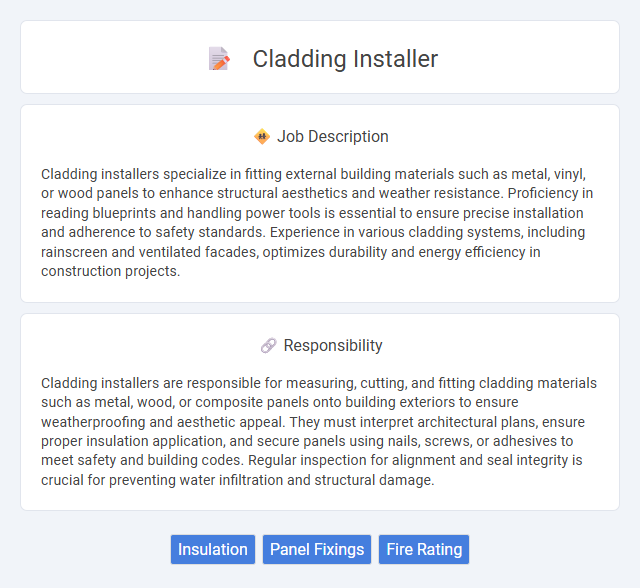
Cladding installers specialize in fitting external building materials such as metal, vinyl, or wood panels to enhance structural aesthetics and weather resistance. Proficiency in reading blueprints and handling power tools is essential to ensure precise installation and adherence to safety standards. Experience in various cladding systems, including rainscreen and ventilated facades, optimizes durability and energy efficiency in construction projects.
Individuals with good physical stamina and strength are more likely to be suitable for cladding installer roles, as the job often involves lifting heavy materials and working in various weather conditions. People comfortable with heights and having agility might perform better due to frequent work on scaffolding or ladders. Those who prefer repetitive tasks or have limited mobility may find this job less suitable.
Qualification
A cladding installer must possess specialized training in construction techniques, including proficiency in handling various cladding materials such as metal panels, vinyl, and composite boards. Certification in safety standards, particularly in working at heights and using scaffolding, is often required to ensure compliance with industry regulations. Practical experience with measuring, cutting, and fitting cladding systems enhances precision and efficiency on installation sites.
Responsibility
Cladding installers are responsible for measuring, cutting, and fitting cladding materials such as metal, wood, or composite panels onto building exteriors to ensure weatherproofing and aesthetic appeal. They must interpret architectural plans, ensure proper insulation application, and secure panels using nails, screws, or adhesives to meet safety and building codes. Regular inspection for alignment and seal integrity is crucial for preventing water infiltration and structural damage.
Benefit
Cladding installers likely enjoy benefits such as competitive wages and opportunities for overtime pay due to project deadlines. Exposure to various materials and installation techniques may enhance career skills, increasing job security and advancement potential. The role often provides outdoor work environments, which some find more appealing than traditional office settings.
Challenge
Cladding installer roles likely present challenges such as working at heights and ensuring precise alignment of materials under various weather conditions. The job may require problem-solving skills to address unexpected material defects or structural inconsistencies. Safety protocols and physical stamina are probably critical factors for success in this occupation.
Career Advancement
Cladding installers gain expertise in installing exterior building materials that protect structures and enhance aesthetics, creating a foundation for career growth in construction. Mastery of diverse cladding systems and compliance with building codes increases opportunities for supervisory roles or specialization in high-rise and commercial projects. Continuous skill development and certifications can lead to positions such as site manager, project coordinator, or estimator, advancing a career in the construction industry.
Key Terms
Insulation
Cladding installers specializing in insulation play a crucial role in enhancing building energy efficiency by installing materials that reduce heat loss and improve thermal performance. These professionals work with various insulation types, such as mineral wool, polystyrene, and polyurethane foam, ensuring tightly sealed, weather-resistant facades. Proper insulation installation by cladding experts significantly lowers heating and cooling costs while contributing to sustainable construction practices.
Panel Fixings
Cladding installer roles prioritize precision in securing panel fixings to ensure structural integrity and weather resistance. Expertise in selecting and installing various fasteners, such as screws, bolts, and anchors tailored to specific cladding materials, enhances durability. Mastery of panel alignment and load distribution techniques reduces the risk of failures and extends the lifespan of building facades.
Fire Rating
Cladding installers specialize in fitting exterior wall coverings that comply with stringent fire rating standards to enhance building safety. They work with materials tested for fire resistance, such as fiber cement, metal panels, and fire-retardant composites, ensuring proper installation to maintain the integrity of fire barriers. Expertise in fire safety codes like ASTM E84 and NFPA 285 is critical for preventing fire spread and meeting regulatory requirements in residential and commercial constructions.
 kuljobs.com
kuljobs.com